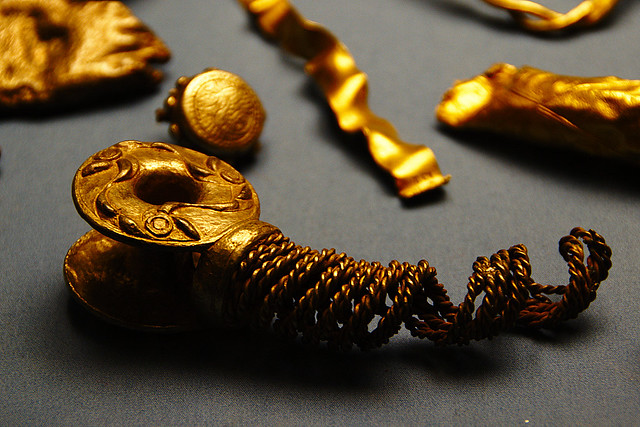The King’s War on Witches: Revealed
This Channel 5 documentary was about the witch hunts in England and Scotland in the 17th Century. As context it talked a little about the witch trials in Europe, which hadn’t spread to England & Scotland until after James VI of Scotland (later also James I of England) began to believe he was the target of a conspiracy of witches trying to assassinate him. As the programme pointed out he’d been the target of more physical assassination attempts several times by the time of his wedding, so when a fierce storm blew up on his & his new wife’s way home from Denmark it didn’t take much of a leap of imagination for him to believe it was deliberately raised to kill him. Once safely home he had several local wise women, or cunning folk, and healers rounded up and eventually under torture some confessed to the witchcraft and assassination attempt and were burnt at the stake. James went on to write a book about hunting witches – what they could do, where they got their powers, what to look out for, what evidence was valid in court of law and so on. This became the primary text used throughout both countries – the programme detailed a few specific cases where women ran afoul of witchfinders and were burnt to death. It also showed some recent archaeological evidence that practices that James VI & I would’ve defined at witchcraft were continuing until at least the 1970s. These were some pits excavated in Cornwall that contain animal or bird skins and eggs, and appear to’ve been ritually laid in the earth at various points in time – one included some plastic, hence the “into the modern day” part.
Sir Gawain and the Green Knight
Simon Armitage has translated Sir Gawain and the Green Knight from the original Middle English into modern English, and this programme was partly telling us the story of the poem and partly about translating the poem. Armitage walked through the sorts of landscapes mentioned in the poem, mostly in the pouring rain, to conjure up the world of the story. Gawain is one of King Arthur’s knights, and one New Year’s Eve a green knight comes to Camelot and challenges the knights – is one of them brave enough to cut off his head, knowing that a year later the knight must go to him and he will cut off the knight’s head in return. Gawain steps up to the challenge, and most of the poem details his journey a year later going to his destiny.
The Ottomans: Europe’s Muslim Emperors
The third and final episode of this series about the Ottoman Empire was mostly about the aftermath of its collapse, and the repercussions of that that are still being felt today. The Empire was torn apart partly by rising nationalist feeling, and partly by the Allies after the end of WWI – the Ottomans had been on Germany’s side. The first half of the programme was a catalogue of states & empires behaving poorly, and the horrific consequences. This included genocide of Armenian Christians by the splintering Ottoman Empire, brutalities brought about by the Greek invasion of Turkey (sponsored by the British, and leading to a “population exchange” where families with roots centuries deep in one country or another were deported “home” as defined by their religion), and the various problems caused by the British Empire promising the same land to multiple groups during WWI. In the second half of the programme Omaar concentrated on Turkey, as both the former heartland of the Ottoman Empire and as one of the success stories of the region. This was less unrelentingly bleak – although when discussing Attaturk Omaar did say that he “wasn’t as bad as Stalin or Chairman Mao” which strikes me as damning with faint praise! Attaturk and his successors strongly believed that the road to success was to Westernise, and that this meant secularise. The tone of the programme was disapproving of this, but some of the interviewees were much more positive (including a woman who’d been a child during Attaturk’s initial reforms and who felt her life was much better as a result of the rights given to women). Modern Turkey has managed to combine both democracy and being an Islamic state, and is also beginning to rehabilitate the reputation of the Ottoman Empire.
This was an odd series in some ways – there were several times when I thought Omaar was glossing over things in an attempt to make the Ottomans sound more tolerant than they actually were. And that continued with a blasé handwave past the more recent protests in Turkey as not really important. However it was still interesting (and reminded me how little I know about the Ottomans in general).
David Starkey’s Music & Monarchy
In this series David Starkey is going to tell us all about the impact the English monarchy has had on English music. It boasts newly recorded performances of the various examples, all of which seem to have Starkey standing or sitting and listening in a pseudo-regal style … The first episode took us from Henry V through to Elizabeth I. Along the way he told us (and showed us) how English church music evolved into a complex (and highly respected) art form. Henry V was a composer himself, as well as a pious man who felt that the best way to get God on his side was to make sure His praises were sung in the best possible way. The story also covered how the foundations of both Eton & King’s College, Cambridge were due to Henry VI’s piety and desire for choirs to praise the glory of God. Henry VIII’s break with Rome was almost disastrous for English church music – although Henry himself kept music as part of church services his much more radically Protestant son wanted to abolish all of that. The day is only saved by Elizabeth’s return to a third way between Protestantism & Roman Catholicism – and her Chapel Royal performed a lot of music as part of services (and leading composers such as Thomas Talis & William Byrd flourished during her reign).
Plastic: How It Works
This is the second episode of Mark Miodownik’s materials series – all about plastics, which he’s defining broadly to encompass any and all artificially created materials. It was a mix of history and chemistry, and started with the discovery of the vulcanisation process for rubber. The first century and more of plastic creation was all about chemical reactions that were poorly understood – Miodownik told us about the atomic structure & properties of these materials but the people creating them often didn’t understand it. In the second half of the 20th Century materials begin to be designed, and this is when plastics made from oil start to be created – the key realisation was that what you wanted to do was polymerise carbon based monomers, and that oil is rich in these building blocks. And the last third of the programme was about the future – we’re turning back to look at biological substances and then trying to engineer new materials with those properties. For instance a sticky tape that uses the same structure as hairs on beetle’s feet to grip glass without glue – demonstrated by sticking a handle to a suspended glass panel & Miodownik dangled from it. He also talked about upcoming medical technology – scaffolding material that encourages cartilage regeneration, for instance.
A Hundred Years of Us
There’s still just enough interesting content in these that we’re continuing to watch – the fourth episode included some fascinating stuff about GI babies. They’d interviewed a woman who was the daughter of an English woman & a black American soldier – she was given up to an orphanage at birth, and subsequently adopted by a family in a Welsh mining village. She did eventually track her parents down – her mother didn’t want anything to do with her because her husband knew nothing about the child & would divorce her if he knew. And her father had died before she could find him, which was also sad. Another interesting segment was about the women sewing machinists who went out on strike for equal pay back in the 60s. The main guest on the programme was Gloria Hunniford who had various anecdotes about the different segments as they related to her – the one that sticks in my mind was when discussing rationing she talked about her mother getting caught smuggling a pair of shoes back into Northern Ireland (from Dublin) in her knickers. Which … how does that even work??










